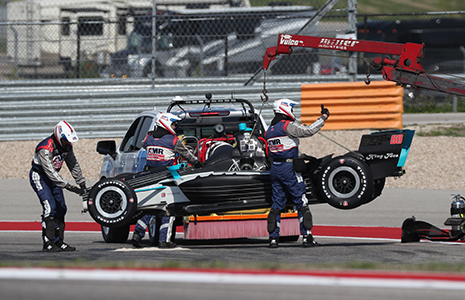AUSTIN, Texas – With the NTT IndyCar Series making its debut at the Circuit of The Americas last weekend, the drivers weren't the only ones putting in lots of hard work to learn a new venue.
The AMR INDYCAR Safety Team spent weeks planning its operations, learning the intricacies of the circuit and going over countless scenarios to ensure a safe INDYCAR Classic weekend. And while he admits it's impossible to anticipate every situation, INDYCAR’s director of track safety, Tim Baughman, knows his team did everything it could to be ready.
“Our team and our planning efforts covers so much that the only gaps that might be left are small, and even in those particular cases, we have a pretty smart group of guys here and they'll problem solve — that's what we do,” Baughman said.
“It's all about orientation and familiarization, and the only way we can bridge that gap is through good planning and good communications, and then get out here and do some laps and get some experience. That's really how we prepare ourselves.”
Interestingly, Baughman helped COTA put together its safety team when it opened nearly eight years ago. That helped give him a good knowledge of the facility and its characteristics unique to other tracks as he began planning for the INDYCAR race weekend at the massive 20-turn, 3.41-mile track.
One of COTA’s interesting quirks is its gravel traps, a difficult combination of large, loose and deep gravel. Not only does that make it difficult to retrieve a car, but the traps also tend to fill the undertray with gravel, which then spills onto the track after the car is freed.
“These are probably the toughest gravel pits that I have seen. They are like quicksand,” Baughman said, adding that two safety trucks were dispatched over the weekend when a car needed rescue from a trap.
 “One (truck was sent) to pull it out and the other to prep to restart the car, and then both teams will work together to clear the gravel away from the undertray and off of the tires,” Baughman explained.
“One (truck was sent) to pull it out and the other to prep to restart the car, and then both teams will work together to clear the gravel away from the undertray and off of the tires,” Baughman explained.
Nothing helps more with planning for racing at a new circuit than getting the cars on track and seeing how they run, Baughman insisted. That's why the INDYCAR Spring Training open test in February at COTA allowed the AMR INDYCAR Safety Team to implement several tweaks to the original plan, including positioning of vehicles around the circuit.
“The open test gave us a chance to kick the tires and figure out what's going to happen,” Baughman said. “After the open test, we determined that we had a lot of incidents in Turns 18 and 19, with spin-offs into the gravel.
“What we did in response was to reposition the Safety 1 crew to Turn 19, which was going to be located near Turn 1. They can get back in the frontstretch in about 10-15 seconds to be right where they were before, and we will now have somebody there from the local crew if something happens.”
In addition to the AMR INDYCAR Safety Team vehicles, there is also a minimum of three local firetrucks on duty, placed in areas that best augment safety support.
Although the open test offered valuable lessons, the AMR INDYCAR Safety Team began planning its operations for the INDYCAR Classic long before fans knew it would be part of the 2019 schedule. When a circuit is being considered for a race, it must first be evaluated to ensure it meets safety standards, as well as to assess its similarities and differences to other tracks. Once a new circuit is added to the NTT IndyCar Series' calendar, things move into high gear.
“We started by questioning the track's operations staff to find out what resources they have and how they met our requirements for an INDYCAR event,” Baughman said.
“Then we started sharing track maps with the Circuit of The Americas staff to see where the resources would be positioned. Obviously, you can look at a track map and see where the places where there are potential high-speed impact points — trouble areas where we want to make sure we have the best coverage — and then after that you look to see the technical sections where you are probably going to have the smaller spins and cars getting together. Then you start prioritizing resources and where you place them.”
Although the AMR INDYCAR Safety Team does everything it can to be ready for everything, it can't be sure every possible incident was considered until the race unfolds. That's why the team always performs a postrace debrief to examine what could be improved for the next time out.
“It's an ongoing process,” said Baughman, who has already begun planning for the return to WeatherTech Raceway Laguna Seca later this year. The last time Indy cars raced at the Monterey, California, road course was in 2004, though some teams tested there in February.
“It starts with the very first event, where you try to build it so you're not surprised. You may overbuild it, but that's OK. And then as you learn and get a better feel and a better understanding, you make tweaks and adjustments using your analysis and postrace reports to do it better and better.”
The AMR INDYCAR Safety Team returns to action at a more familiar facility along with the drivers and teams for the Honda Indy Grand Prix of Alabama on the weekend of April 5-7. This year's event marks the 10th for the NTT IndyCar Series at Barber Motorsports Park. Tickets for the race weekend are available at barberracingevents.com. The race airs live at 4 p.m. ET Sunday, April 7 in NBCSN and the Advance Auto Parts INDYCAR Radio Network.